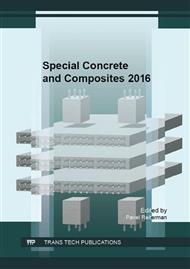p.27
p.33
p.38
p.44
p.52
p.59
p.66
p.72
p.81
Residual Mechanical Properties of Hybrid Fiber Reinforced HPC Exposed to High Temperatures
Abstract:
The effect of high temperature load on mechanical properties and porosity of a newly designed Ultra High Performance Fiber Reinforced Concrete (UHPFRC) is studied. The hybrid reinforcement of UHPFRC is based on a mixture of polypropylene and steel fibers. In order to identify influence of high temperature exposure on UHPFRC, its residual mechanical parameters such as compressive strength, flexural strength and Young’s modulus of elasticity are accessed. Moreover, residual bulk density, matrix density and total open porosity are examined and related to the monitored structural changes. Simultaneous Thermal Analysis (STA) is employed in order to describe transformation processes during high temperature loading. The conducted tests provide practical information for controlled regulation of water vapor transport in a low permeable cementitious composite in order to decrease risk of spalling.
Info:
Periodical:
Pages:
52-58
Citation:
Online since:
December 2016
Authors:
Price:
Сopyright:
© 2017 Trans Tech Publications Ltd. All Rights Reserved
Share:
Citation:


